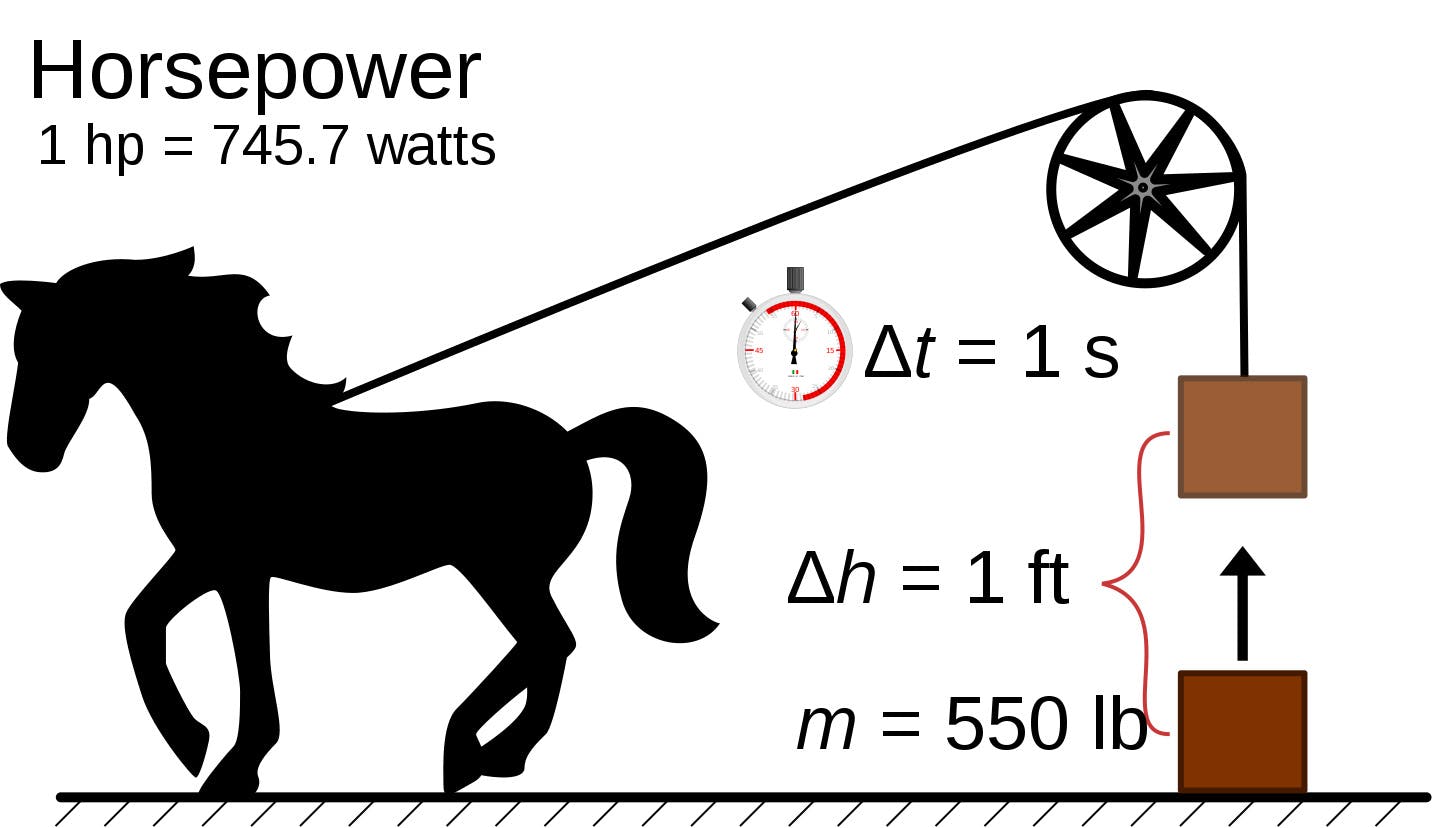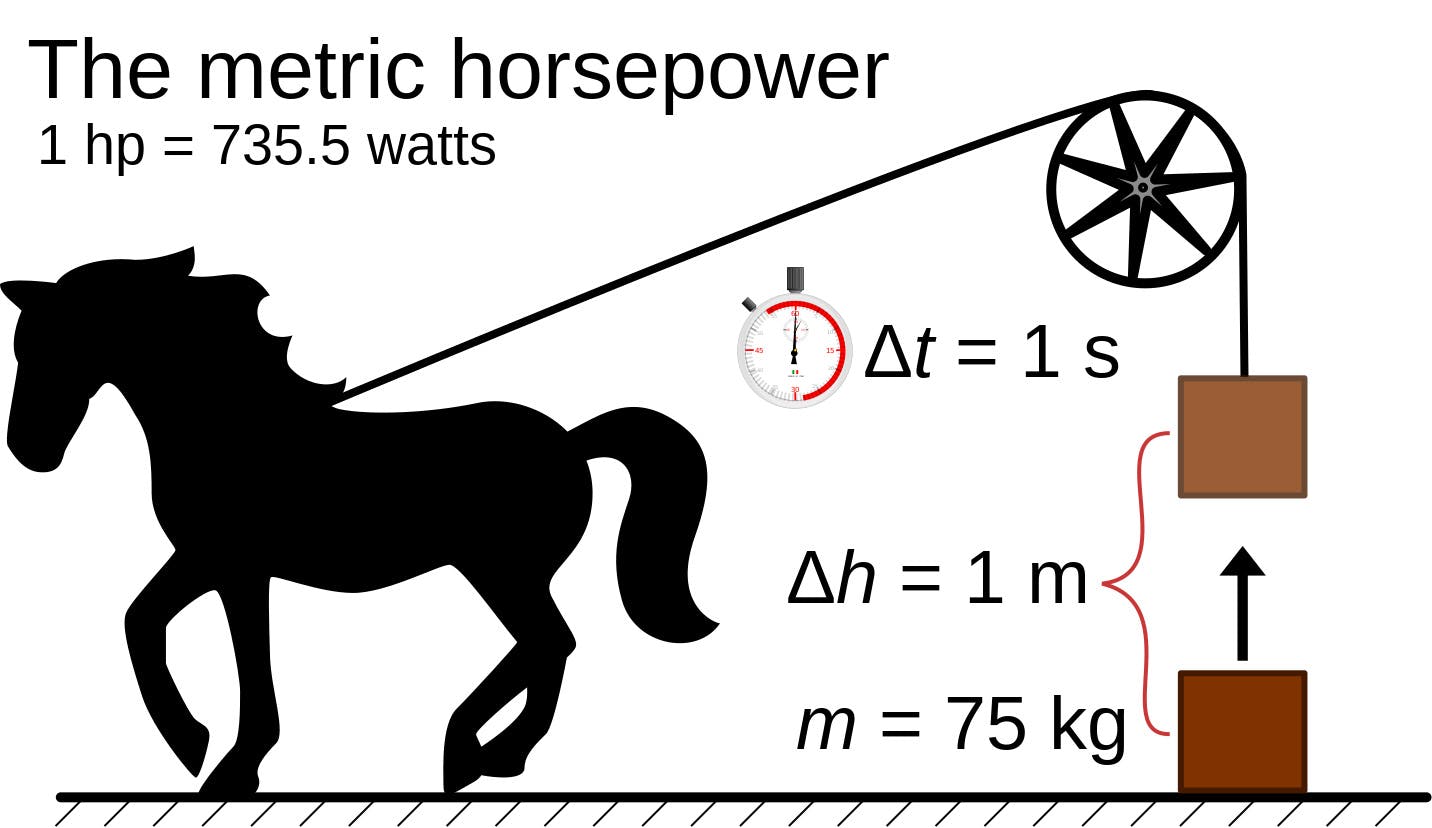Horsepower: What is it, and why is it important?

Horsepower is a term frequently used in the automotive industry, and it refers to the power output of an engine. One horsepower is equivalent to the power needed to lift 550 pounds one foot in one second or 33,000 pounds one foot in one minute.
This article will examine horsepower as a unit for measuring an engine's power, its importance, calculation, and the difference between various measurements.
Indholdsfortegnelse
Horsepower History in a Nutshell
The term was first coined by Scottish inventor James Watt in the late 18th century to help market his improved steam engine. He based his idea on The Miner's Friend, written by English inventor and engineer Thomas Savery:
"So that an engine which will raise as much water as two horses, working together at one time in such a work, can do, and for which there must be constantly kept ten or twelve horses for doing the same. Then I say, such an engine may be made large enough to do the work required in employing eight, ten, fifteen, or twenty horses to be constantly maintained and kept for doing such a work..."
It made sense to measure the output of the steam engine in the late 18th century in horsepower since the value literally meant the number of horses that the engine could replace. It was extremely convenient for potential buyers to understand the engine's output.
So where does the number 33,000 pounds one foot in one minute come from? Watt observed a horse turning a mill wheel 144 times in an hour or 2.4 times per minute. By including the radius of the wheel and the distance horse traveled in one minute, he calculated one horsepower as 32,572 ft-lb/min. A year later, this number was standardized by Watt and Matthew Boulton at 33,000 foot-pounds per minute.
Horsepower Calculation
P = (T × N) / k
P- Horsepower (calculation's output)T- Torque, which can either be in pound-foot (ft-lb) or inch-pounds (in-lb)N- Rpmk- Constant, if torque (T) is in pound-foot, then it's equal to 5252; if the torque is in inch-pounds, it's equal to 63,025
Importance of Horsepower

Horsepower is often used as a selling point for new cars and trucks in the automotive industry. Consumers are often drawn to vehicles with higher horsepower ratings, as they are seen as more powerful and capable than those with lower ratings.
However, it's important to note that horsepower is just one factor in determining a vehicle's performance. Other factors, such as torque, aerodynamics, and weight, can significantly impact a vehicle's overall performance.
When it comes to measuring horsepower, there are a few different methods that can be used. The most common method is to use a dynamometer, a device that measures the power output of an engine under load. This method provides a relatively accurate measure of an engine's power output, and car manufacturers and tuners often use it to optimize the performance of their engines.
Why is horsepower preferred over watts for measuring engine power?
It's impractical as a measurement for most engines and machines since the power output is very high. One horsepower is exactly 746 watts, so you can imagine that even less performant engines would easily yield five digits in watts.
Metric Horsepower

Horsepower is also used in Europe but calculated differently since the feet are replaced by meters, and pounds are replaced by kilograms of force. The difference is that the metric equivalent of horsepower is abbreviated as PS (from the German word Pferdestärke, meaning "horsepower"). When looking at the performance specs of European cars, you can also come across the term CV (from the Italian Cavalli Vapore).
Metric horsepower (PS) is 98.6% of one HP or the other way round — 1.4% less than the SAE horsepower. European Union defines kilowatts (kW) as an official measure, but horsepower is preferred in everyday descriptions. Simply put 1 Imperial horsepower = 1.014 Metric horsepower.
Why is there a difference between US HP and European HP?
In the US, they use SAE standards; in Europe, they use DIN, which stands for Deutsche Industrie Normen - German Industrial Standard. The difference is that the SAE horsepower is the power to lift 33,000 lbs in one foot in one minute. In comparison, DIN defines one metric horsepower as the power to lift 4500 kilograms over a distance of one meter in one minute.
Electrical Horsepower
One horsepower equals 746 watts (W) or 0.746 kilowatts (kW) in SI (International System of Units). There is no difference between electrical and mechanical horsepower. To calculate horsepower from watts, multiply the value in watts by 0.00134. On the other hand, to get watts, multiply the horsepower value by 746.
Difference between HP, BHP, and WHP
As said, horsepower refers to the power output of an engine. Brake horsepower has nothing to do with your car's braking system. Evaluating an engine's power output often involves using a dynamometer, a mechanical brake that can apply variable loads to a running engine, thus the term brake horsepower.
Dynamometer allows for calculating torque and power at different engine revs, with brake horsepower being the figure quoted at a given RPM. Brake horsepower is the maximum power output excluding the frictional losses at the drivetrain.
Frictional losses cause, to put simply, loss of power, i.e., even if your car has 200 HP, it would not be able to achieve this power on the road. Friction occurs in the drivetrain and gearbox. Depending on the transmission, drivetrain, etc., the car might generally lose from 15% to 25% of the power. For instance, AWD takes between 20-25% of the power.
Wheel Horsepower (WHP)
It's perhaps the most relevant measurement since it reflects more realistic figures of how much power the car can achieve on the road. WHP is measured at the wheels using a chassis dynamometer and is always lower than horsepower or BHP since it factors in frictional losses.
Car manufacturers tend to emphasize the horsepower figure and politely ignore the WHP since it is always a lower figure. Lower figures don't sell well.
How much Horsepower does a human have?
A healthy human adult can produce and sustain around 1.2 hp (or 0.89 kW) for a brief period of time — this value drops to one-tenth of one horsepower if we're talking about a longer period.
A professional athlete can, on the other hand, sustain around 2.5 hp (1.9 kW) for a brief period and 0.35 hp for a longer period. For instance, Usain Bolt — a Jamaican sprinter — peaked at 3.5 hp (2.6 kW) during his 100-meter (109.4 yards) sprint in 2009.
Conclusion
In conclusion, horsepower is a term commonly used to describe the power output of an engine. While it's important in determining a vehicle's performance, it's not the only factor. Other factors, such as torque, aerodynamics, and weight, can significantly impact a vehicle's overall performance.